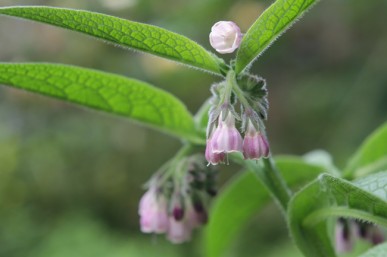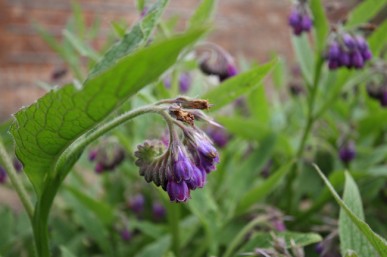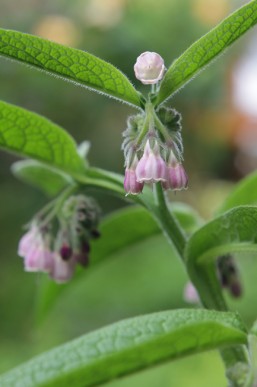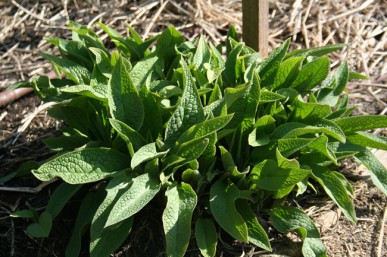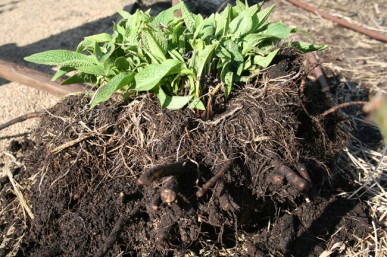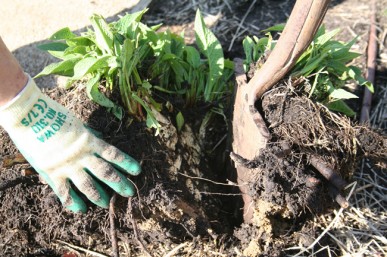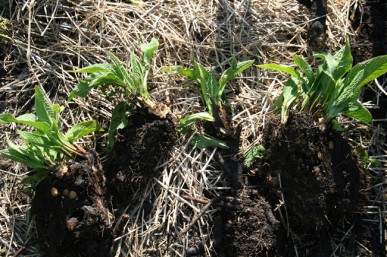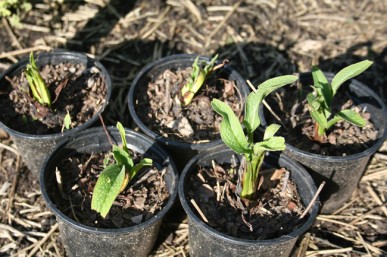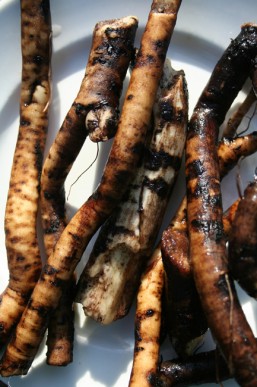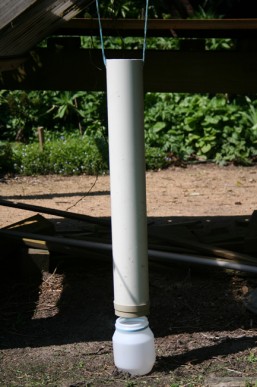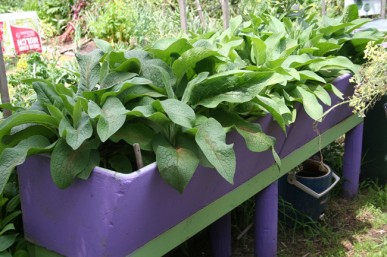By Penny Woodward
Comfrey (Symphytum species) is a multi-purpose plant that has a place in every organic and permaculture garden. It comes originally from Europe and is an herbaceous perennial in the Boraginaceae family. It’s natural habitat is damp, grassy places like river banks and ditches. The large, hairy leaves grow in a clump up to a height of about 1m and about 1m across. Flowers are bell-like, grow in clusters and can be mauve, purple, pink and white.
The most common forms are S. officinale and S. x uplandicum (Russian comfrey, a cross between officinale and another species). Other comfrey species are available as garden plants with attractive flowers, but all share the possibility of becoming problem weeds as they spread by creeping roots and many also self-sow.
The exception to this is a variety of S. x uplandicum known as Bocking 14. This plant has an interesting history. Russian comfrey was first introduced to Britain in about 1910 by the Quaker pioneer, Henry Doubleday. The Bocking 14 cultivar was developed during the 1950s, by Lawrence Hills, the founder of the Henry Doubleday Research Association (HDRA). It was chosen from over 20 different varieties trialled by Hills because Bocking 14 was the highest yielding with high potash content. It was named after the place it was developed, Bocking, near Baintree in the UK. Bocking 14 is sterile, so doesn’t set seed and can only be propagated by division. Although sterile, Bocking 14 will keep increasing in size, so it is wise to dig it up and divide it up every few years
Growing
Comfrey is a tough, easy to grow plant that thrives from the tropics to cool temperate regions. In cool climates the plant will die right back in winter, re-shooting in spring. While in the sub-tropics and tropics plants rarely flower, as there is not enough winter chill, but they also don’t die back so the leaves are available all year round.
Propagating
Grow new plants of comfrey from root cuttings or crown division from healthy vigorous clumps. This just means that if you dig up a clump, new plants will grow from almost any piece of root separated from the main clump. Alternatively drive a spade through the clump to divide it. Each piece is then replanted. Pot up the spare pieces and pass them on to friends. If planting roots, place them about 3cm below the soil surface. Separated clumps are replanted with the growing tips just below the soil surface. In either case, keep moist until new growth appears. Comfrey is best divided in spring in temperate regions and in the wet season in the tropics. But comfrey is tough and adaptable and can really be divided at any time of the year.
If you are growing more than one plant, leave about half a metre between plants. Choose the position carefully as although comfrey is easy to transplant if you decide it’s in the wrong position, it can be difficult to remove all traces of roots, so it may keep regrowing. I have had success though, by covering the clump that I no longer want with several layers of wet newspaper, mulching over the top with straw and leaving for at least twelve months. The comfrey rotted and I was left with lovely rich composty soil for the next resident.
Comfrey will survive with very little attention but it does best with extra moisture and regular additions of manure or other high nitrogen mulches like grass cuttings. Twice a year, just spread the manure or fresh grass cuttings on the surface of the soil and allow the nutrients to leach down.
Harvesting
Comfrey leaves can be harvested 4 or 5 times a year. Leaves are cut about 5 cm above the soil. The first cutting is generally made in mid-spring, and leaves can be regularly cut until early autumn in cooler regions. After this, leave plants to build up winter reserves before they die back completely in early winter. In warmer regions leaves can be cut all year round but still only 4-5 times per year. Fine hairs on the leaves can irritate some people so wear gloves when you are harvesting.
Medicinal
Comfrey has been used for centuries, both internally and externally, for all sorts of problems, but research in the last 50 years has shown that it can cause liver toxicity. So this somewhat controversial herb is now on the poisons schedule in Australia. It would take too much space to explain both sides of the controversy so this is a topic for another day. However it is still very useful externally, made into a poultice or cream, for a range of skin problems as well as sprains, burns, ulcers and even broken bones. But this versatile plant is even more useful in the garden.
A nutritional powerhouse
Comfrey leaves contain high levels of potash, and reasonable levels of nitrogen and phosphate, as well as small amounts of calcium, iron, magnesium and silica. When measured as dry matter, comfrey has been shown to contain between 15 and 30% protein, which is comparable to legumes. For this reason they make an excellent fodder for pets and livestock especially poultry and rabbits. Also bees love the flowers
Uses in the garden
I couldn’t manage without my comfrey and its ability to build high quality organic soil. Comfrey is known as a dynamic accumulator because it’s roots accumulate nutrients from the soil and make them available in the leaves. So grow comfrey in the low point of the garden or somewhere else where nutrients may accumulate. For example at a point where a pond overflows, or close to where the compost might drain or downhill from the chook run or other animal pens. The deeply penetrating roots trap excess nutrients that might otherwise be washed away. This way, when the leaves are used, nutrients leached from the topsoil are recycled back into the garden. This attribute is especially important in areas of high rainfall where nutrient leaching is more of a problem.
Mulch
Use the leaves in layers about 5 cm thick over the surface of the soil. The leaves break down rapidly and provide nutrients to the crops. Comfrey is particularly good for fruiting crops because of the good levels of potash. When planting potatoes, lay comfrey leaves in the bottom of the trench and place the potatoes on top. Or plant clumps of comfrey in the orchard. The leaves are then regularly slashed or mown and left on the surface of the soil to break down.
Comfrey liquid manure
Fill a large container with comfrey leaves, cover with water and a lid and leave for four weeks. Leaves readily de-compose making a very useful (if extremely malodorous) liquid manure. This fast-acting liquid food can be used as it is on established plants or diluted about 5 to 1, and used for seedlings, pots, and ailing plants.
Alternatively, firmly pack comfrey leaves into a wide pipe, weight with a stone and suspend the pipe above a small container. The pipe should be blocked at the bottom end with just a small hole in the middle. The comfrey leaves rot down releasing a dark liquid that collects in the small container. Dilute this by about 15 to 1 and use in the same way as liquid manure.
Compost activator
Comfrey added to the compost not only rots down quickly but also adds nutrients and speeds up the decomposition of other materials. I grow one clump of comfrey near the compost to remind me to add a leaf every time I add other materials. Other plants in the Boraginaceae family, like borage and forget-me-nots, also break down quickly in the compost.
Weed barrier
Comfrey is used as a weed barrier because it is able to stop running grasses from spreading. It needs to be planted in a strip several plants wide and it’s important to use only non-seeding, non-spreading varieties otherwise you will only be replacing one weed problem with another.
Slug and snail trap
Big comfrey leaves are attractive to slugs and, to a lesser extent, snails. So try layering the leave around but some distance from young seedlings. Each morning pick up the leaves and remove the slugs and snails that are sheltering and feeding there. Drop these into soapy water and replace the leaves to trap more slugs.
Comfrey in potting mix
Comfrey is added to decayed leaf mould with a little dolomite to make a good organic general potting mix.
As you can see, comfrey is used in many different ways in the organic garden. Like compost, it is a source of nutrients in the home garden that means we do not have to be dependent on external sources to improve our soils. There are no packaging or transport costs so decreasing our carbon footprint and adding to sustainability.
Comparative Nutritional Analysis of manure, comfrey and compost
(from LD Hills’ book Comfrey, Past Present and Future)
| Material |
Water % |
Nitrogen (N) % |
Phosphorus (P) % |
Potash (K) % |
Carbon-Nitrogen ration |
| Farm Yard Manure | 76.0 | 0.64 | 0.23 | 0.32 | 14 – 1 |
| Wilted Russian Comfrey | 75.0 | 0.74 | 0.24 | 1.19 | 9.8 – 1 |
| Indore Compost | 76.0 | 0.50 | 0.27 | 0.81 | 10 – 1 |

